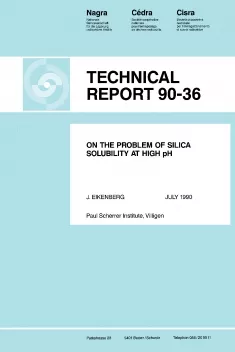
Technical Report NTB 90-36
On the problem of silicia solubility at high pH
The aqueous system Na2O-H2O-SiO2 is considered to play an important role when strong alkaline pore waters of a cement based intermediate level radioactive waste repository intrude into the rock formations surrounding the near field. Under such conditions unknown quantities of silica may dissolve. Therefore the pH-dependence of the solubility of amorphous silica and quartz is investigated by a parameter variation study using the geochemical speciation code MINEQL/EIR. Published silica solubility data obtained in sodium hydroxide solutions at 25 and 90°C are compared with the results of four models which use different proposed values of the rather uncertain equilibrium constants. Of main interest is the question of whether, in a high pH region, the silica solubility can be explained with different monomeric species only, or to what extent additional polymeric silica species have to be considered as well. Furthermore, the influence of silica-sodium ion pairing under such extreme conditions is also studied.
The solubility of amorphous silica at 25°C is well understood up to a pH of about 10.5, where it is determined by the solubility product and the first dissociation constant of monomeric silicic acid. In more alkaline media the total solubility increases dramatically. This behaviour is less well understood due to uncertainties of the second deprotonation and polymerisation constants. Despite these uncertainties, it is shown that the most probable cause of the increased solubility of amorphous silica in the region between pH 10.5 and 11.3 is the formation of dimers, trimers and tetramers. Below a total silica concentration of 0.01 M and pH ≤ 10.0, however, polymerisation proves to be insignificant.
Besides low temperature studies using amorphous silica, the solubility of quartz has also been measured in NaOH solutions at 90°C. As is the case at lower temperatures, the reported values for the second dissociation constant at 90°C scatter widely. Although it is not possible to extract this value from the few analytical data, it can be shown that in a NaOH medium up to 0.1 M only mononuclear silica species are stable. Therefore it is concluded that the trend of monomers to form polymers decreases strongly with temperature. In addition, there are indications that, in strong NaOH solutions at elevated temperatures, silica-sodium ion pairing gains importance.
